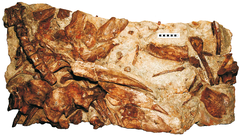
Back Hileosaure Catalan Hylaeosaurus Czech Hylaeosaurus German Hylaeosaurus armatus Spanish هیلائوسور Persian Hylaeosaurus French הילאוזאורוס HE Hylaeosaurus Hungarian Hylaeosaurus armatus Italian ヒラエオサウルス Japanese
| Hylaeosaurus Temporal range: Valanginian
~ | |
|---|---|

| |
| Holotype NHMUK PV OR 3775 | |
| Scientific classification | |
| Domain: | Eukaryota |
| Kingdom: | Animalia |
| Phylum: | Chordata |
| Clade: | Dinosauria |
| Clade: | †Ornithischia |
| Clade: | †Thyreophora |
| Clade: | †Ankylosauria |
| Clade: | †Euankylosauria |
| Family: | †Nodosauridae |
| Genus: | †Hylaeosaurus Mantell, 1833 |
| Species: | †H. armatus
|
| Binomial name | |
| †Hylaeosaurus armatus Mantell, 1833
| |
| Synonyms | |
| |
Hylaeosaurus (/haɪˌliːoʊˈsɔːrəs/ hy-LEE-o-SOR-əs; Greek: hylaios/ὑλαῖος "belonging to the forest" and sauros/σαυρος "lizard") is a herbivorous ankylosaurian dinosaur that lived about 136 million years ago, in the late Valanginian stage of the early Cretaceous period of England. It was found in the Grinstead Clay Formation.
Hylaeosaurus was one of the first dinosaurs to be discovered, in 1832 by Gideon Mantell. In 1842 it was one of the three dinosaurs Richard Owen based the Dinosauria on, the others being Iguanodon and Megalosaurus. Four species were named in the genus, but only the type species Hylaeosaurus armatus is today considered valid. Only limited remains have been found of Hylaeosaurus and much of its anatomy is unknown. It might have been a basal nodosaurid, although a recent cladistic analysis recovers it as a basal ankylosaurid.[1]
Hylaeosaurus was about five metres long. It was an armoured dinosaur that carried at least three long spines on its shoulder.
- ^ Arbour, Victoria M; Zanno, Lindsay E; Gates, Terry (2016). "Ankylosaurian dinosaur palaeoenvironmental associations were influenced by extirpation, sea-level fluctuation, and geodispersal". Palaeogeography, Palaeoclimatology, Palaeoecology. 449: 289–299. Bibcode:2016PPP...449..289A. doi:10.1016/j.palaeo.2016.02.033.